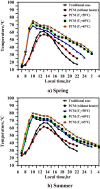Exergoeconomic and enviroeconomic evaluations of conventional solar still using PCM and electric heater powered by solar energy: an experimental study
- PMID: 37097568
- PMCID: PMC10182951
- DOI: 10.1007/s11356-023-26761-4
Exergoeconomic and enviroeconomic evaluations of conventional solar still using PCM and electric heater powered by solar energy: an experimental study
Abstract
Solar stills are used in distant and arid areas to convert brackish or salty water into potable water fit for human use in a simple, affordable, and effective manner. Even when PCM materials are used, typical solar systems still have minimal production per day. In this study, experimental tests were carried out in order to increase the performance of a single-slope solar still combined with PCM material (paraffin wax) and a solar-powered electric heater. Two identical single-slope solar stills were designed, fabricated, and tested under the same climatic conditions during the summer and spring seasons of 2021 in Al-Arish, Egypt. The first is a conventional solar still (CVSS), and the other is also a conventional still but with PCM and an electric heater (CVSSWPCM). Several parameters were measured during the experiments, including sun intensity, meteorological aspects, cumulative freshwater production, average glass, and water temperatures and PCM temperature. The improved solar still was evaluated at different operating temperatures and was compared to the conventional traditional one. There were four cases studied: one case without a heater (paraffin wax only) and three other cases with a heater operating at 58 °C, 60 °C, and 65 °C, respectively. The experimental results revealed that activating the heater inside the paraffin wax increased daily production (i) in the spring by 2.38, 2.66, and 3.1 times and (ii) and in the summer by 2.2, 2.39, and 2.67 times at the three above-mentioned temperatures respectively (when compared to the traditional still). In addition, the maximum rate of daily freshwater production was achieved at paraffin wax temperature of 65 °C in both spring and summer (Case 5). Finally, the economic evaluation of the modified solar still was carried out according to cost per litre. The modified solar still with a heater operating at 65 °C has a higher exergoeconomic value than the traditional one. The maximum CO2 mitigation in cases 1 and 5 was approximately 28 tons and 160 tons, respectively.
Keywords: Desalination; Freshwater production; PCM; Performance; Solar energy; Solar heater; Solar still.
© 2023. The Author(s).
Conflict of interest statement
The authors declare no competing interests.
Figures



















References
-
- Abdullah S, Essa F, Bacha HB, Omara Z. Improving the trays solar still performance using reflectors and phase change material with nanoparticles. J Energy Storage. 2020;31:101–144. doi: 10.1016/j.est.2020.101744. - DOI
-
- Abdullah S, Omara Z, Essa F, Younes M, Shanmugan S, Abdelgaied M, Amro M, Kabeel A, Farouk W. Improving the performance of trays solar still using wick corrugated absorber, nano-enhanced phase change material and photovoltaic-powered heaters. J Energy Storage. 2021;40:102–182. doi: 10.1016/j.est.2021.102782. - DOI
-
- Ahmed H, Najib A, Zaidi A, Naseer M, Kim B. Modeling, design optimization and field testing of a solar still with corrugated absorber plate and phase change material for Karachi weather conditions. Energy Rep. 2022;8:11530–11546. doi: 10.1016/j.egyr.2022.08.276. - DOI
-
- Alawee W, Abdullah A, Mohammed A, Majdi A, Omara Z, Younes M (2022) Testing a single slope solar still with copper heating coil, external condenser, and phase change material. J Energy Storage 56(B), 103‒106
-
- Andrassy Z, Szantho Z. Thermal behavior of materials in interrupted phase change. Therm Anal Calorim. 2019;138:3915–3924. doi: 10.1007/s10973-019-08541-w. - DOI
MeSH terms
Substances
LinkOut - more resources
Full Text Sources

